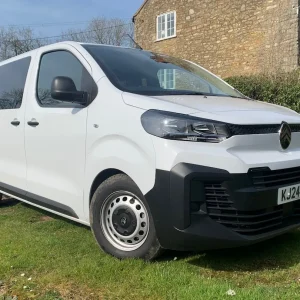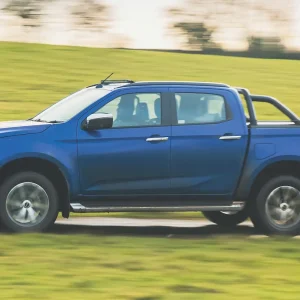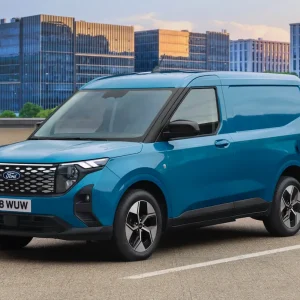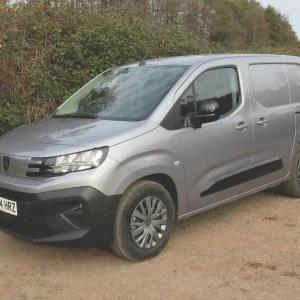Engine and gearbox
The biggest news with the new D-max is that it has a new engine – in fact, Isuzu has downsized, replacing the old 163hp 2.5 unit with a 1.9 turbo-diesel that produces 164hp.
This has resulted in a decrease in maximum torque from 400Nm to 360Nm, but UK boss William Brown insists the low gearing, with a very short throw between first and second gear, compensates for the reduction and the truck’s 3.5t towing capacity is retained.
“When you drive it it’s engineered for towing,” he says, “so it feels more powerful because of the gearing.”
Brown admits it may take customers, particularly farmers who can be a conservative bunch, some time to completely trust that a hard-worked 1.9-litre engine will stand up to the same amount of punishment as the outgoing 2.5-litre drivetrain.
He is confident, however, the Isuzu engineers have produced an engine that will prove to be rugged and durable enough to cope with all that’s thrown at it.
The manufacturer claims development simulations showed 1.9 litres to be the optimum size to blend efficiency and achieve the torque necessary for the D-max to retain its core workhorse capabilities. All demonstrators are fitted with tow bars to allow dealers to show off the truck’s workhorse credentials.
What should appeal to punters who may be resistant to change is the fact that the D-max is now the only pick-up on the market not requiring the addition of AdBlue to meet the Euro6 emissions regulation.
Brown points out that a 64kg weight saving from the new engine has led to a payload increase of about 50kg across the range and enabled the inclusion of a spare wheel.
Isuzu claims the new engine delivers considerable improvements in both CO2 and combined-cycle fuel economy.
Official CO2 output for the 4×2 2017 model-year D-max is 163g/km, an 18.5% reduction on the 2015 model-year truck, emissions for the 4×4 six-speed manual are put at 183g/km, down 4.7% and the six-speed auto comes in at 205g/km – a 6.8% cut. In terms of fuel consumption the brand claims 45.6mpg for the 4×2, a 22.5% increase, 40.4mpg for the 4×4 manual represents a more modest 4.4% boost, and 36.2mpg for the auto is 7.7% more frugal than the 2015 (five-speed) automatic.
By way of comparison, the Nissan Navara, which is officially the most frugal pick-up on the market, turns in a claimed 159g/km CO2 and 44.1mpg for a double-cab manual and 174g/km CO2 with 40.3mpg for the auto.
Interior and equipment
In terms of design the latest D-max gets a new front bumper, bonnet, grille, and headlights with LED daytime running lights. The distance between the bonnet and the engine has been increased to create a crumple zone to improve pedestrian safety.
The wedge-shaped front and bolder front wings give the truck a sportier, more powerful stance and Isuzu claims a more aerodynamic roof line has reduced drag by 0.4% compared with the 2015 iteration, resulting in better fuel consumption and less cabin noise. A modest restyling of the rear includes a spoiler design moulded into the tailgate and a re-shaped handle.
Isuzu has spruced up the interior, which now gets an easier to read display and easier to use buttons than before. Manual models now get the obligatory gear shift indicator to nudge drivers to improve fuel economy.
All models except for the entry-level Utility now come with additional USB ports, and fabric seats have been upgraded in the Eiger and Yukon while the Utah and Blade get new leather seats. Utility is the only trim that does not now benefit from padded front centre and side armrests.
Impressively, all versions of the D-max now benefit from Hill Start Assist and Variable Hill Descent Control. The former applies the brakes for a couple of seconds while the driver moves from the brake to the accelerator pedal, preventing the car from rolling back on a hill start. Hill Descent Control controls the brakes, maintaining a consistent low speed when descending steep, slippery slopes.
We got behind the wheel of the D-max Utah with the new six-speed automatic transmission. This version comes with a generous amount of kit but lacks the flashier touches that adorn the Blade, such as logoed carpet mats, illuminated front footwells, aluminium door sill covers and ‘Blade’ puddle lamps.
Curiously, the Utah does get an electrically adjustable driver’s seat while the Blade is fitted with a manually adjusted seat. On the other hand, the Utah has to make do with a seven-inch touchscreen compared to the Blade’s nine-inch display, and the Blade also benefits from front, as well as rear, parking sensors.
Impressively though, all D-max models from the Eiger up are now equipped with a reversing camera, although oddly, only the top two get the reversing sensors.
DAB radio is new to the 2017 Utah, as is keyless entry with a push-button start system, and satellite navigation is also now bundled in. Stepping up from Yukon to Utah also adds automatic air-conditioning, Apple CarPlay and Android Auto, roof bars and heated front seats.
A well-positioned step and grab handle eases entry into the cab, which is soberly black and reasonably classy, although some of the fittings are not the most robust and the plastic does not seem to be of the highest quality under close scrutiny.
The six-speed automatic is much better than the previous five-speed version but is not a match for the best, particularly the eight-speed Volkswagen Amarok automatic. There are slight lags between changes and engine noise can be mildly intrusive.
Driving
Without a load on board the rear end bounces about on rougher roads, but when towing a vehicle and with bales of hay in the back the D-max is stable and composed. Taller back-seat passengers may suffer from limited legroom but overall comfort is decent enough, if not class-leading.
Isuzu UK is keen to promote the new D-max as continuing in the tradition established by its predecessor, which succeeded the Rodeo in 2012, in being a truck that is not afraid of getting dirt under its tyres.
This is a tad disingenuous because Brown admits, the D-max cannot compete at the top end of the lifestyle sector with the likes of the Volkswagen Amarok, Ford Ranger Wildtrak or Nissan Navara Tekna, which, he points out, are not likely to be found putting in a shift down on the farm.
“We won’t compete with the 3.0-litre Amarok or Ranger,” he says. “Our core is as a working LCV.”
But the latest-generation D-max does not lack refinement – it is offered in a range of single-, extended- and double-cab modes and in five trim levels: the entry-level Utility, the Eiger, Yukon, Utah and the new flagship Blade, which started life as a special-edition model. Prices start from £15,749 and rise to £26,999, excluding VAT.
D-max sales in the UK reached a peak of 6,219 in 2015 before dropping back slightly to 5,718 last year with the old model on run-out. This year, Isuzu is forecasting sales of 6,900 in a rapidly expanding sector that it predicts will grow by a further 4.8% to hit the 50,000 mark.
Isuzu D-max double-cab Utah Auto
Price (ex VAT) £25,149
Price range (ex VAT) £15,749-£27,999
Insurance 40A
Warranty 5yrs/125,000mls
Service intervals 12,000mls
Load length 1,485mm
Load width (min/max) 1,110mm/1,530mm
Load bay height n/a
Load volume n/a
Gross payload 1,091kg
Engine size/power 1,898cc/164hp
Combined fuel economy 36.2mpg
CO2 205g/km





